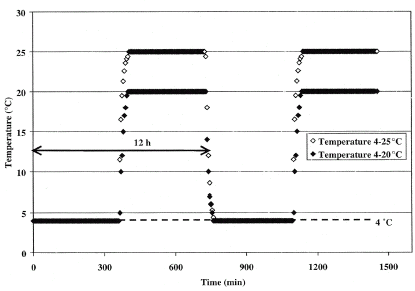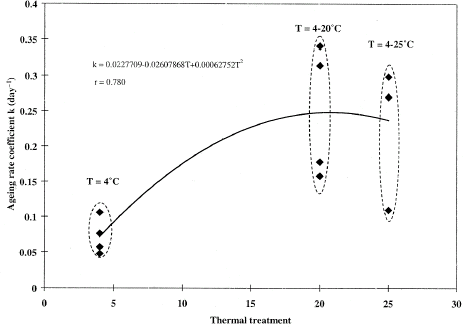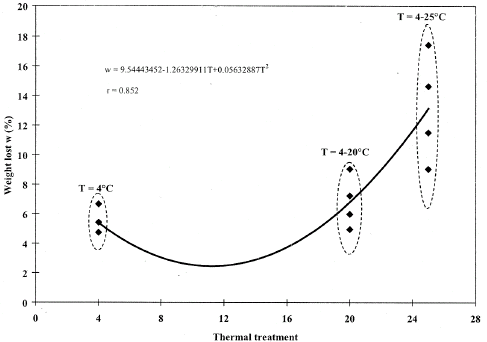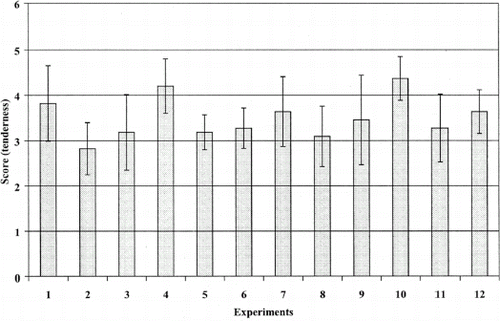Abstract
Semimembranosus and Semitendinosus muscles (one day after slaughter) were used to study intermittent thermal treatments of 4–20 and 4–25°C as an alternative method to reduce ageing time and improve beef tenderness. A number of samples thermostated at 4°C were used as the basis for comparison. The evolution of muscle tenderness with storage time was measured by the compression method using an INSTRON 4442 machine at 20% deformation. At the end of the thermal treatment process, weight loss in muscle was determined and a sensory evaluation of meat was carried out. It was found that intermittent thermal treatment reduced the ageing time by 50–70% in relation to studies done at 4°C. However, muscle weight loss was elevated, varying from 10 to 15% compared to 5% observed on the samples treated at 4°C. The results of the sensory evaluation indicated that meat tenderness treated at 4–20 and 4–25°C was comparable to samples treated at 4°C (p < 0.10).
Introduction
Tenderness of beef is one of the most important aspects of eating quality.Citation[1] Immediately after the animal is killed, the muscle presents a considerable tenderness. However, this tenderness decreases rapidly as muscle enters rigor mortis and reaches a maximum of toughness when muscle contraction ceases.Citation2–4 Different tenderization techniques have been proposed and utilized by the meat industry. Ageing process (conditioning) is a traditional method used to improve meats tenderness.Citation5–7 Meat ageing involves the breakdown of the myofibrillar muscle proteins by endogenous enzymes, which convert the muscle into meat, resulting in improved meat tenderness, flavor and color.Citation[8] For the ageing process, carcasses or half carcasses are stored for long periods (i.e., 1–2 weeks) at 4°C and at high relative humidity to reduce overall weight loss.Citation[9] However, in developing countries, there is little interest in the meat industry in the ageing process, mainly because the process is expensive. The traditional process in Mexico involves cooling the carcasses for 24–48 h in order to attain a final meat temperature of 7°C before transportation or cutting. Therefore, the meat is distributed and consumed while muscle is reaching the maximum toughness. Another tenderization technique involves the use of proteolytic enzymes such as papaine, bromeline and ficine. Although the method is cost effective and fast, enzymes are believed to produce side effects in humans.Citation[10]
Therefore, there is considerable interest in methods that shorten ageing times with reduced processing costs that result in tenderized meat. These tenderization methods include calcium chloride or calcium lactate injections;Citation11–15 marinating treatment of muscle in solutions of acetic and lactic acid;Citation[16] Citation[17] carcass electrical stimulation;Citation18–21 and/or storage at high temperatures (40°C).Citation[22] The use of different temperatures applied during the installation of rigor mortis in bovine muscles has been also proposed by several authors.Citation23–26 These authors observed that muscle tenderness is temperature dependent, at a maximum between 14 and 21°C and a minimum between 0 and 7°C. This behavior was attributed mainly to the prevention of cold shortening at 14–21°C and to an increase of sarcomere shortening at 0–7°C. However, studies on the effect of temperature on tenderness in post rigor bovine and porcine muscle are limited.
It was noted that in many of the studies mentioned previously, a reduction of the ageing time was possible. Nevertheless, the organoleptic properties of the meat were not absolutely satisfactory. Thus, novel tenderization methods with a reasonable maturation time of the muscle and an improvement in the quality of the meat are necessary. The aim of this study was to evaluate, as an alternative method to reduce the ageing time and to improve beef muscle tenderness, an intermittent thermal treatment process applied after rigor mortis.
Materials and Methods
Animal and Sample Selection
Semimembranosus (SM) and Semitendinosus (ST) muscles from eight animals (3 years old, 450 ± 50 kg carcasses) of hybrid breed F1 (50% Bos taurus and 50% Bos indicus) were obtained 24 h postmortem from a commercial slaughterhouse. Six muscles SM and six muscles ST were obtained. Due to the destructive nature of the tenderness measurement (as described later), several parallelepipeds of approximately 10 × 5 × 4 cm were excised from each muscle, taking into account the longest dimension of the muscle fibres. These parallelepipedic samples were individually weighed and vacuum packed in polyethylene bags to avoid microbial growth.
Thermal Treatment of Muscle
Thermal treatment tests were carried out on the lots of samples with three different temperature–time profiles as shown in Fig. . Two muscles (1 for SM and 1 for ST) were chosen for a constant thermal treatment at 4°C and used for comparison purposes. Another 2 muscles (1 for SM and 1 for ST) were used to evaluate intermittent thermal treatments at 4–20°C and another two (1 for SM and 1 for ST) for intermittent thermal treatment at 4–25°C. In all experiments, the samples were thermostated with a water bath. As thermal treatment proceeded, samples were removed for tenderness measurement. These treatments were continued until the final maximum stress of samples reached a range value of approximately 40–100 kPa. At the end of the thermal treatment process, muscle weight loss was determined and a sensory evaluation of the meat was carried out. Experiments were performed in duplicate for each muscle. A total of 12 runs were conducted (Table ).
Table 1 Experimental conditions for the thermal treatment studies
Evaluation of Meat Tenderness
For tenderness measurements, the method proposed by Lepetit and BuffiereCitation[27] was used. First, all the samples were stabilized at a temperature between 18 and 20°C prior to analysis. For each experiment, at least 10 parallelepipeds of approximately 1×1×3 cm were excised from the original sample (parallelepiped of 10 × 5 × 4 cm). The samples were analyzed by compression with an Instron testing machine (Model 4442), up to 20% strain at a speed of 50 mm/min. The surface of the probe was 1 cm2. The compression was perpendicular to the muscle fibers so that samples could deform laterally only in the direction of the muscles fibers. In this work, the tenderness of samples was interpreted as the force (kPa) needed to stress the muscle at 20% deformation.
Determination of Weight Loss
At the end of the corresponding thermal treatment processes, the polyethylene bags containing the parallelepipeds samples (10×5×4 cm) were opened and drained. Muscle samples were immediately weighed using a digital balance (OHAUS) with 8 kg capacity (± 0.001 kg).
Sensory Evaluation of Meat Tenderness
Tenderness of treated muscle was also subjected to a sensory evaluation. The sensory analysis was carried out with a 12 semi-trained judges panel, between 25 and 30 years of age. Panelists were originally selected from 25 potential candidates after receiving 18 sessions of training. For the sensory evaluation, four different sessions on four different days were used. In the first and second sessions, the tenderness of SM muscles corresponding to Exp. 1, 3, 5 and Exp. 7, 9, 11, respectively was evaluated (Table ). Three samples per session were used (1 treated at 4°C, 1 at 4–20°C, and 1 at 4–25°C). All the samples were cooked at 80°C for 90 min using a water bath. After cooking, the samples were cut in 2 cm3 cubes and served in open recipients without the addition of any chemical component or dressing. Panelists scored the tenderness of meat after 5 chews using a ranking test with a 5 point scale, where 5 = very tender and 1 = very tough. In the third and fourth sessions, the same procedure and the same criteria were followed to evaluate ST muscles corresponding to Exp. 2, 4, 6 and Exp. 8, 10, 12, respectively (Table ).
Mathematical Modeling of Maximum Stress Curve
A linear differential equation of first order (Eq. (Equation1)), was used to determine the maximum stress rate of meat as a function of time (exponential decay):
Statistical Analysis
Regression analysis was performed using Microsoft Excel 2000. A linear model (Eq. (Equation3)) and a quadratic model (Eq. (Equation4)) were used to evaluate the main effects of the independent variables (thermal treatment, type of muscle, and their replicate) on each of the response variables:
Results and Discussion
Experimental Results and Modeling of Maximum Stress Evolution with Storage Time
The variations of maximum stress (S) for muscles ST and SM with storage time at different thermal treatments of 4, 4–20 and 4–25°C are shown in Figs. (a–d). Each experimental value represents the mean of at least 10 independent measurements. The estimated values (Eq. (Equation2)) are also shown in these figures for comparison with the experimental data. The corresponding constants k and S 0 obtained with Eq. (Equation2) and the coefficient of determination (r 2) for each experimental condition investigated are shown in Table . Figure shows that the maximum muscle stress decreased continuously with storage time. In all experimental conditions investigated, the proposed model fitted the experimental data providing r 2 values higher than 0.8 (except for experiment 2, Table ). From Figs. (a–d), it was evident that the decrease of S in samples treated at a constant temperature of 4°C was less pronounced than in that samples treated with the intermittent thermal treatment of 4–20 and 4–25°C. As an indication that muscle ageing was completed, a value of S between 40–100 kPa was considered in this work. The time needed to reach this S value with thermal treatment at 4–20 and 4–25°C was between 6–8 days, while at 4°C, more than 16 days were necessary. These results indicated that the time required for the ageing process of muscle was considerably reduced with intermittent thermal treatments. It is important to indicate that the evolution of S with storage time at 4°C in this work agreed with those reported by other authors when similar experimental conditions were used.Citation[28] However, it is difficult to reach a definite conclusion on the behavior of maximum stress at different experimental conditions by simple observation of Fig. . Therefore, a statistical analysis based on the “ageing rate coefficient” (k) was carried out to identify the influence of process variables with a significant level of 90% (p < 0.10). Regression analyses with a linear model (Eq. (Equation3)) and with a quadratic model (Eq. (Equation4)) were used. The coefficient of determination (r 2), the levels of significance p(t) (t-student probability) of the constant, and regression coefficients and p(F) (Fisher probability) of the model were used as the primary criteria to determine the goodness of fit of each equation. The regression coefficients for both models and their respective analyses of variance (ANOVA) are shown in Table . The linear model showed that the factor having greater significance on the value of k was the thermal treatment. The level of significance of the coefficient A 1 was p(t) = 0.0109, whereas the type of muscle and its replicate were not significant. The results of Table show that the highest value of r 2 and the lowest value of p(F) were obtained with the quadratic model (0.6085 and 0.0147 respectively). Thus, it can be assumed that the quadratic model may be selected to represent the k behavior.
Table 2 Values of the ageing rate coefficient (k) and initial maximum stress (S 0) determined with Eq. (Equation2)
Figure 2 Variation of experimental and predicted maximum stress (S) at 20% deformation of muscle with storage time at different thermal treatments. (a) SM muscle (Exp. 1, 3, 5); (b) Repetitions with SM muscle (Exp. 7, 9, 11); (c) ST muscle (Exp. 2, 4, 6); (d) Repetitions with ST muscle (Exp. 8, 10, 12).
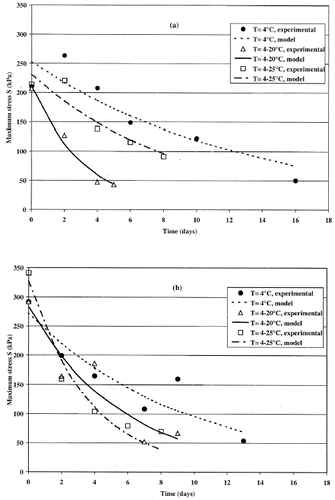
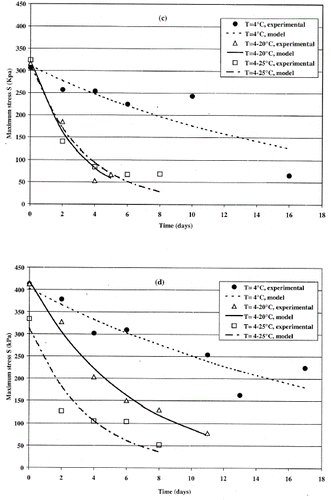
Figure represents the evolution of the ageing rate coefficient (k) as a function of the thermal treatment. From this Figure, it may be noted that the lowest values of k were obtained for experiments conducted at constant thermal treatment (4°C). The predicted values of k with intermittent thermal treatment (4–20 and 4–25°C) were at least three times greater than the predicted values of k, with temperatures at 4°C. This model also indicated that above 4–25°C, there is an important decrease of k. The reason may be that, at T > 25°C, there is a denaturalization of the enzymes responsible for the degradation of proteins, and proteolysis is reduced. The general susceptibility of muscle proteins to denaturalization at temperatures above 35°C has already been shown.Citation[29] Citation[30] It would also be of interest to carry out experiments with intermittent thermal treatments at temperatures below 20°C. Therefore, the knowledge of the ageing rate coefficient (k) supported this work, indicating that the ageing time of SM and ST muscles was reduced by 50–70% when intermittent thermal treatments at 4–20 and 4–25°C were used, in comparison with treatment at 4°C.
Muscle Weight Loss: Experimental and Predicted Values
A statistical analysis to select the best models, between Eqs. (Equation3) and (Equation4) was applied in this section, using the same procedure and criteria as those used in the analysis of k. Through this analysis, the influence of process variables on muscle weight loss was evaluated. The results of statistical analyses applied to these models are given in Table . According to the linear model, weight loss was only influenced by the thermal treatment (p < 0.10) based on the p(t) value of 0.0228 observed by the coefficient A 1. However, a highest p(F ) value and a lowest r 2 value were obtained by using this model compared with the r 2 and p(F) values calculated with the quadratic model (Table ). Therefore, the quadratic model may be selected to represent the weight loss behavior of samples.
The predictive capability of the quadratic model can be observed in Fig. . The analysis of this Figure together with experimental data (measured at the end of the ageing processes), showed that weight loss of samples was affected by temperature. As temperature increased, a corresponding increase of water loss in the samples was observed. Samples treated at 4°C showed a weight loss of approximately 4–5%. This percentage of weight loss was similar to values reported by Ambroasiadis et al.Citation[31] and Lepetit et al.Citation[32] for ageing of beef muscles over a period of 14 days at 4°C. However, muscle weight loss varied from 7–10% to 15% when the muscles were treated at 4–20 and 4–25°C, respectively. Obviously, such high percentages in weight loss during the ageing process are detrimental from an economic point of view. Nevertheless, the values of weight loss predicted by the model are quite interesting, since they predict that, within a range of 4–10 and 4–14°C, the weight loss in muscle would be minimal. Honikel et al.Citation[25] found that pre rigor bovine and porcine muscles exhibited minimum weight loss in storage at temperatures between 10–12°C, which they attributed to minimum shortening of sarcomere obtained at this temperature interval. These authors found that at temperatures below 6°C and above 20°C, there was an abrupt increase of sarcomere shortening and consequently an elevated weight loss. Under these conditions, the matrix shrinks and expels the water entrapped in the fibrillar network. The result is a release of water and a decrease in the water holding capacity of the meat.Citation[33] It is likely that a similar phenomenon could explain the weight loss in muscle for the temperature interval considered in this study. Additional experiments to determine the weight loss and sarcomere length of muscles in the range of 4–10 and 4–14°C are necessary to confirm this assumption.
Sensorial Tenderness of Meat
Figure shows the results of the test for tenderness for both SM and ST muscles. Each experimental value represents the mean of the score given by the panel. All samples were considered acceptable by the panel. The samples that received the highest scores were for experiments 4 and 10 (4.2 and 4.4) treated at 4–20°C, and the lowest scores were for samples from experiments 2 and 8 (2.81 and 3.09) treated at 4°C. In both cases, ST muscles were used. The scores received for experiments conducted with SM muscle were more homogeneous and varied between 3.20 (Exp. 5) and 3.81 (Exp. 1). However, it was found that the regression model (Eq. (Equation3)) for the sensorial tenderness parameters was not significant at p < 0.10 (results not shown). The level of significance (p(t) value) of all coefficients was greater than 0.6 and the p(F) value (ANOVA) was 0.8782. It is evident that meat tenderness was not affected by the type of thermal treatment or by the type of muscle, and there were no significant differences between all the samples evaluated in this study. Therefore, the sensorial tenderness of meat treated either at 4–20 or 4–25°C would be similar to what one would expect to obtain for meat stored at 4°C, as in the normal ageing process (conditioning) used by the meat industry.
Conclusions
This study showed that with the use of intermittent thermal treatments in post rigor bovine muscles, ageing time can be considerably reduced and meat with acceptable tenderness obtained. The effect of thermal treatment on the evolution of maximum stress of muscle with storage times could be explained by the “ageing rate coefficient,” k. This coefficient indicated that the ageing time of SM and ST muscle was reduced in the order of 50–70% with intermittent thermal treatment (4–20 and 4–25°C) with respect to samples treated at 4°C. However, the samples lost between 10 and 15% of weight with this tenderization method. Regarding the sensorial tenderness of meat, no significant effect of the thermal treatment was registered (p < 0.10). The tenderness of the meat treated at 4–20 and 4–25°C was similar to reference samples treated at 4°C. This study also showed that further research on intermittent thermal treatments between 4–10 and 4–14°C is required. It is possible that, in this temperature interval, the values of k would be similar or superior to the experimental conditions tested in this study, but with a muscle weight loss under 5%.
References
- Boleman , S.J. , Boleman , S.L. , Miller , R.K. , Taylor , J.F. , Cross , H.R. , Wheeler , T.L. , Koohmaraie , M. , Shackelford , S.D. , Miller , M.F. , West , R.L. , Johnson , D. and Savell , J.W. 1997 . Consumer evaluation of beef of known categories of tenderness . J. Animal Sci. , 75 : 1521 – 1524 .
- Goll , D.E. , Henderson , D.W. and Kline , E.A. 1964 . Post mortem changes in physical and chemical properties of bovine muscle . J. Food Sci. , 29 : 590 – 596 .
- Koohmaraie , M. , Shackelford , S.D. , Wheeler , T.L. , Lonergan , S.M. and Doumit , M.E. 1995 . A muscle hypertrophy condition in lamb (callipyge): characterization of the effects on muscle growth and meat quality traits . J. Animal Sci. , 73 : 3596 – 3607 .
- Ouali , A. 1991 . Consequences des traitements technologiques sur la qualite de la viande . INRA Production Animal , 4 ( 3 ) : 195 – 208 .
- Valin , C. and Kopp , J. 1978 . Influence des facteurs technologiques sur la tendreté des viandes bovines . Industries Alimentaires et Agricoles. , : 315 – 326 .
- Ouali , A. 1990 . Meat tenderization: possible causes and mechanisms . A review. Journal of Muscle Foods , 1 : 129 – 165 .
- Taylor , R.G. 1998 . Structural basis for meat toughness and tenderness . Polish J. F. N. Sci. , 7 : 37 – 52 .
- Xiong , Y.L. 1999 . “ Meat processing ” . In Food Proteins Processing Applications Edited by: Nakai , S. and Wayne , M.H. 89 – 145 . USA : WILEY-VCH .
- James , S.J. and Bailey , C. 1990 . “ Chilling of beef carcasses ” . In Chilled Food the State of the Art Edited by: Gormley , T.R. 159 – 181 . Elsevier Applied Science .
- Prändl , O. , Fischer , A. , Schmidhofer , T. and Sinell , H. 1994 . “ Estructura y propiedades tecnológicas de la carne ” . In Tecnología e Higiene de la Carne Edited by: Acribia , S.A. 108 – 141 . Zaragoza España .
- Morgan , J.B. , Miller , R.K. , Mendez , F.M. , Hale , D.S. and Savel , J.W. 1991 . Using calcium chloride injection to improve tenderness of beef from nature cows . J. Animal Sci. , 74 : 1842 – 1845 .
- Wheeler , T.L. , Koohmaraie , M. and Crouse , J.D. 1991 . Effects of calcium chloride injection and hot boning on the tenderness of round muscles . J. Animal Sci. , 69 : 4871 – 4875 .
- Got , F. 1997 . “ Acceleration des Processus de Maturation de la Viande Bovine par Traitement Technologiques: Injections de Calcium; Applications D'ultrasons de Puissance. Thèse Docteur (Spécialité: Sciences des Aliments) ” . 172 pp Clermont-Ferrand, , France : Université Blaise Pascal .
- Koohmaraie , M. and Shackelford , S.D. 1991 . Effect of calcium chloride infusion on the tenderness of lambs fed a β-adrenergic agonist . J. Animal Sci. , 69 : 2463 – 2471 .
- Gault , N.F.S. 1985 . The relationship between water holding capacity and cooked meat tenderness in some beef muscle as influenced by acidic conditions below the ultimate pH . Meat Sci. , 15 : 15 – 30 .
- Kijowski , J. and Mast , M.G. 1993 . Tenderization of spent fowl drumsticks by marination in weak organic solutions . I. J. F. Sci. Tech. , 28 : 337 – 342 .
- Berge , P. , Ertbjerg , P. , Larsen , L.M. , Astruc , T. , Vignon , X. and Moller , A.J. 2001 . Tenderization of beef by lactic acid injected at different times post mortem . Meat Sci. , 57 : 347 – 357 .
- Kastner , C.L. , Schwenke , J.R. , Kenney , P.B. , Campbell , R.E. , Kendall , J.A. and Milliken , G.A. 1993 . Comparisons of the effect of electrical stimulation methods on postmortem pH decline in beef muscles . Meat Sci. , 35 : 183 – 190 .
- Dutson , T.R. , Smith , G.C. and Carpenter , Z.L. 1980 . Lysosomal enzyme distribution in electrically stimulated ovine muscle . J. F. Sci. , 45 : 1097 – 1098 .
- Marsh , B.B. , Lochner , J.V. , Takahashi , G. and Kragness , D.D. 1981 . Effects of early post mortem pH and temperature on beef tenderness . Meat Sci. , 5 : 479 – 483 .
- Wiklund , E. , Stevenson-Barry , J.M. , Duncan , S.J. and Littlejohn , R.P. 2001 . Electrical stimulation of red deer (Cervus elaphus) carcasses-effects on rate of pH decline, meat tenderness, colour stability and water-holding capacity . Meat Sci. , 59 : 211 – 220 .
- Lawrie , R.A. 1998 . “ Calidad comestible de la carne ” . In Ciencia de la Carne, , 3rd Ed. Edited by: Acribia , S.A. 245 – 296 . Zaragoza España .
- Locker , R.H. and Hagyard , C.J. 1963 . A cold shortening effect in beef muscles . J. Sci. F. Agri. , 14 : 787 – 793 .
- Grajales-Lagunes , A. 1999 . “ Interactions Mecaniques Entre les Fibres de Collagene et les Fibres Musculaires Dans la Viande au Cours du Chauffage. Thèse Docteur (Spécialité: Sciences des Aliments) ” . 139 pp Clermont-Ferrand, , France : Université Blaise Pascal .
- Honikel , K.O. , Kim , C.J. and Hamm , R. 1986 . Sarcomere shortening of prerigor muscles and its influence on drip loss . Meat Sci. , 16 : 267 – 282 .
- Ress , M.P. , Trout , G.R. and Warner , R.D. 2002 . Tenderness of pork m. longissimus thoracis et lumborum after accelerated boning. Part I . Effect of temperature conditioning. Meat Sci. , 61 : 205 – 214 .
- Lepetit , J. and Buffiere , C. 1993 . Comparaison de deux méthodes mécaniques de mesure de la résistance myofibrillaire de la viande crue . Viandes et Produits Carnés , 14 ( 2 ) : 39 – 42 .
- Lepetit , J. , Salé , P. and Ouali , A. 1986 . Post-mortem evolution of rheological properties of the myofibrillar structure . Meat Sci. , 16 : 161 – 174 .
- Hamm , R. 1960 . Biochemistry of meat hydration . Adv. Food Res. , : 355 – 463 .
- Penny , I.F. and Dransfield , E. 1979 . Relationship between toughness and troponin T in conditioned beef . Meat Sci. , 3 ( 2 ) : 135
- Ambroasiadis , I. , Theodorakakos , N. , Georgakis , S. and Lekas , S. 1994 . Influence of thawing methods on the quality of frozen meat and drip loss . Fleischwirtsch , 74 ( 3 ) : 284 – 287 .
- Lepetit , J. , Grajales , A. and Favier , R. 2000 . Modelling the effect of sarcomere length on collagen thermal shortening in cooked meat: consequence on meat toughness . Meat Sci. , 54 : 239 – 250 .
- Motarjemi , Y. 1988 . “ A Study of Some Physical Properties of Water in Foodstuffs. Ph. D. thesis ” . Lund, , Sweden : Lund University .
